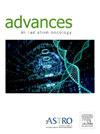软组织肉瘤肿瘤进展模型的扩散加权磁共振成像翻译评价的最佳设置和参数。
IF 2.2
Q3 ONCOLOGY
引用次数: 0
摘要
目的:确定显微肿瘤浸润边界对放射治疗的成功至关重要。目前,放射肿瘤学家在软组织肉瘤(STS)的放射治疗计划中使用边缘来几何扩展可见肿瘤。基于图像的肿瘤进展模型对于个性化治疗放射场对肉瘤扩散模式至关重要。评估这些模型是必要的,以证明在临床环境的可行性。本研究提出了一种用于四肢STS肿瘤进展模型临床前评估的影像学方案。方法和材料:我们招募了7名健康志愿者,在放射肿瘤科用于癌症患者成像的磁共振成像扫描仪上获得了大腿弥散加权磁共振成像(DW-MRI)图像。我们制定了一个协议,包括定位病人,配置射频线圈,并设置DW-MRI序列参数。为了找到最优的参数配置,计算了图像信噪比(SNR)和扩散张量主特征向量的方向变异性(DV)。结果:所有试验和12块大腿肌肉的平均信噪比为41,范围为12至72。平均DV为13°,范围为11°~ 23°。最长扫描时间为22分58秒,最短扫描时间为11分46秒。对于体素体积为1.3 × 1.3 × 6 mm3、38个切片的高分辨率图像,最佳参数为重复时间8000 ms、12个信号平均、6个梯度方向。该配置的扫描时间为11分46秒,信噪比为34,DV为13°。结论:DW-MRI扫描时间可用于癌症患者成像,图像质量适合肿瘤浸润的可重复性建模。开发的方案可用于STS患者的临床前评估。本文章由计算机程序翻译,如有差异,请以英文原文为准。
Optimal Setup and Parameters of Diffusion-Weighted Magnetic Resonance Imaging for Translational Evaluation of a Tumor Progression Model for Soft Tissue Sarcomas
Purpose
Defining a microscopic tumor infiltration boundary is critical to the success of radiation therapy. Currently, radiation oncologists use margins to geometrically expand the visible tumor for radiation treatment planning in soft tissue sarcomas (STS). Image-based models of tumor progression would be critical to personalize the treatment radiation field to the pattern of sarcoma spread. Evaluation of these models is necessary to demonstrate feasibility in the clinical setting. This study presents an imaging protocol for the preclinical evaluation of a tumor progression model in extremity STS.
Methods and Materials
We recruited 7 healthy volunteers and acquired diffusion-weighted magnetic resonance imaging (DW-MRI) images of the thigh on a magnetic resonance imaging scanner used for imaging cancer patients in a radiation oncology department. We developed a protocol that includes positioning the patient, configuring the radiofrequency coils, and setting the DW-MRI sequence parameters. To find the optimal parameter configuration, the image signal-to-noise ratio (SNR) and the directional variability (DV) of the principal eigenvector of the diffusion tensor were calculated.
Results
The mean SNR across all trials and 12 thigh muscles was 41, with a range of 12 to 72. The mean DV was 13° and ranged from 11° to 23°. The longest scan time was 22 minutes and 58 seconds, and the shortest was 11 minutes and 46 seconds. For the high-resolution image with a voxel volume of 1.3 × 1.3 × 6 mm3 and 38 slices, the optimal parameters were found to be a repetition time of 8000 ms, 12 signal averages, and 6 gradient directions. This configuration resulted in a scan time of 11 minutes and 46 seconds, an SNR of 34, and a DV of 13°.
Conclusions
A DW-MRI scan duration acceptable for imaging cancer patients was achieved with an image quality suitable for reproducible modeling of tumor infiltration. The developed protocol can be used for preclinical evaluation in STS patients.
求助全文
通过发布文献求助,成功后即可免费获取论文全文。
去求助
来源期刊

Advances in Radiation Oncology
Medicine-Radiology, Nuclear Medicine and Imaging
CiteScore
4.60
自引率
4.30%
发文量
208
审稿时长
98 days
期刊介绍:
The purpose of Advances is to provide information for clinicians who use radiation therapy by publishing: Clinical trial reports and reanalyses. Basic science original reports. Manuscripts examining health services research, comparative and cost effectiveness research, and systematic reviews. Case reports documenting unusual problems and solutions. High quality multi and single institutional series, as well as other novel retrospective hypothesis generating series. Timely critical reviews on important topics in radiation oncology, such as side effects. Articles reporting the natural history of disease and patterns of failure, particularly as they relate to treatment volume delineation. Articles on safety and quality in radiation therapy. Essays on clinical experience. Articles on practice transformation in radiation oncology, in particular: Aspects of health policy that may impact the future practice of radiation oncology. How information technology, such as data analytics and systems innovations, will change radiation oncology practice. Articles on imaging as they relate to radiation therapy treatment.
 求助内容:
求助内容: 应助结果提醒方式:
应助结果提醒方式:


